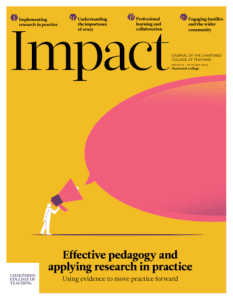Welcome Matviy: Working in staff–student partnerships to develop simulation-based learning to support teachers’ understanding of EAL

Carl Luke, Chris Counihan, David Nichol, Sophie Meller, Kirstin Mulholland, William Gray, Arlene Anderson, Deborah Herridge, Northumbria University, UK
Diana Karikis, Rowan Sanderson, Elisa Collard, Ryan Hill, students and pedagogic consultants, Northumbria University, UK
Teacher preparedness and EAL
Over the last decade, the percentage of pupils in state-funded primary schools whose first language is known or believed to be one other than English has increased from 12.3 per cent to 21.3 per cent (DfEDepartment for Education - a ministerial department responsible for children’s services and education in England, 2022). More recently, since Russia’s invasion of Ukraine, this issue has assumed even greater prominence in national conversations. However, despite the increasing likelihood that teachers will support pupils with refugee status as well as those with English as an additional language (EAL), research asserts that many new teachers feel ill-prepared for supporting these pupils and lack confidence in this aspect of their role (Bell Foundation, 2020).
To better prepare student teachers at Northumbria University (NU), students and staff are piloting simulation-based learning (SBL) as a pedagogical technique with the potential to bridge the gap between theory and practice by providing authentic contexts for difficult-to-teach concepts (Mulholland et al., 2022). This case study reflects on our collaborative experiences as we developed SBL to support student teachers’ understanding of the challenges faced by pupils with EAL, as well as how to support them in the primary classroom. It provides an overview of the simulation, concerning Matviy, a fictitious Ukrainian refugee. We reflect on the process and share insights into the impacts of the SBL scenario on student teachers’ feelings of confidence and preparedness for supporting pupils with EAL.
The potential of simulation-based learning
Evidence in support of SBL is drawn from existing studies in social work (Meredith et al., 2021) and health (Platt et al., 2021) and emerging research in teacher education (Mulholland et al., 2022), which suggest benefits for student teacher outcomes, confidence and feelings of preparedness. SBL is also associated with increased transferability of theoretical knowledge into practice, providing a safe space within which to consider complex and authentic problems (O’Shea et al., 2022). However, when designing SBL opportunities and scenarios, the extent to which student teachers’ voices can and should be used to inform the development of these is unclear.
Adopting a co-constructive approach to curriculum development facilitates the professional learning of both students and staff, as they learn from one another in a collaborative partnership (Mulholland and O’Connor, 2016). This approach follows the work of Murphy (2012) around reverse mentoring techniques, as well as that of Bovill (2020), who promotes the benefits of co-construction for embedding critical thinking and applying theoretical knowledge in practice. However, it is important to acknowledge limitations to co-construction, including time constraints (Dixon et al., 2018), challenges in navigating institutional systems and procedures (Dwyer, 2018), and the hierarchical nature of student–staff relationships (Chase and Hedley, 2019).
Student–staff collaborations in curriculum design remain relatively rare, with pedagogic decisions usually made by academic staff (Bovill, 2020). Nevertheless, while it is important to navigate potential working relationships carefully to ensure participation and opportunity for all parties, we adopt the position that student teachers are ‘expert witnesses’ in their education (Lodge, 2005, p. 129), meaning that they are ideally placed to support and inform decision-making on initiatives and innovations related to their own educational provision.
Development of the simulation scenario
In developing the simulation scenario for this case, we were influenced by Bailey and Sowden’s (2021) reflective account of teaching pupils with EAL in a primary setting, which cautions teachers not to treat them as a heterogeneous group, and to view their transition into a UK classroom as a broader task than solely supporting English language skills. Findings demonstrate that, to inclusively adapt provisions for EAL pupils, teachers need to know how to welcome pupils from diverse cultural, ethical and religious backgrounds, and understand that some may be resettling in the UK as migrants, refugees or asylum seekers (Bailey and Sowden, 2021; Bell Foundation, 2020).
Although only 588 Ukrainians had claimed asylum by the end of July 2022, nationally the UK received 72,027 asylum applications, doubling the number of applicants from those in 2019 (Home Office, 2022). Teachers of refugees and asylum-seekers should be particularly cautious in understanding the unique child and avoid generalising their pre- and post-migration experience, in order to discover an appropriate pedagogy for their needs (Rutter, 2006). Schools are pivotal in the social inclusionAn approach where a school aims to ensure that all children are educated together, with support for those who require it to access the full curriculum and contribute to and participate in all aspects of school life and resettlement of refugees and families seeking asylum (Cook, 2023). In our SBL scenario, we made a deliberate decision to initially introduce Matviy without a detailed pupil history or profile, emphasising to student teachers that an EAL teacher must first fully understand the child’s needs and background in order to value, respect and support their UK socioemotional integration as a foundation for all English teaching (Bell Foundation, 2020; Cook, 2023).
When exploring the support strategies to be discussed in the simulation, a number of areas were identified that could then be considered when discussing accommodations for Matviy and his family. The simulation adopts a staged approach to enable reflection between sessions (Moon, 1999) prior to the introduction of more complex scenarios. Before the simulation, a brief outline of the focus, together with supporting documents, is shared with student teachers. This allows them to familiarise themselves with key theories and information, thus lessening extraneous cognitive load (Reedy, 2015). The simulation also utilises a multi-part structure, consisting of ‘live’ face-to-face input, interspersed with opportunities for directed learning tasks.
Underpinning most if not all other considerations is the culture from which the child has migrated (Stafford, 2018; Khwala et al., 2021). Evidence suggests that through respectful exploration that values the child’s culture, mental health, self-worth and personal identity, outcomes for refugee children can generally be improved (Stafford, 2018; Khwala et al., 2021). Therefore, an important aspect of SBL scenario involved student teachers’ researching Matviy’s home culture, followed by strategies for incorporation of this into the school context.
The educational input that the child has received prior to migrating must be considered ahead of the development of any intervention or support plan. As Kashyap (2022) outlines, numerous factors may impact prior education, including but not limited to disability, poverty, gender, colonisation and cultural perceptions of education. If a child needs additional intervention or is identified as having a learning need or disability, then it would be necessary to prepare student teachers to inform and support families to engage with relevant support systems (Kashyap, 2022). When considering our simulated character, Matviy, it was therefore important to make explicit any emerging or identified needs and provide guidance for sourcing additional support.
Finally, it was particularly important to provide opportunities to practise discussions surrounding trauma and mental wellbeing, addressing an experience gap highlighted by our student partners. Stafford (2018) provides a series of suggestions for such situations, which were then condensed to suit an SBL. Children should feel able to discuss trauma or mental health, although at the same time they should not be forced to ‘relive’ the experience in order to receive support. Should the child be unable to discuss their past, it becomes essential for the teacher to identify any signs of poor mental wellbeing or particular triggers in the school environment, and consider how these may be mitigated.
Reflections on the co-construction process
All student teachers involved reported that they felt more prepared for supporting pupils with EAL, and the co-construction process helped to develop their understanding of socioemotional and cultural inclusion of refugee and migrant children. Student teachers valued the opportunity to develop resources for future cohorts and highlighted SBL as a valuable pedagogic approach for developing confidence and feelings of preparedness for their professional responsibilities.
As an academic, co-constructing this SBL session provided opportunities to develop knowledge of EAL teaching strategies and review current literature on the UK’s migrant and refugee population. The opportunity to reflect on our SBL session content and structure was invaluable, allowing opportunities to refine and revise course materials to meet the needs of our new teachers and the wider school community.
- Bailey L and Sowden H (2021) Reflective accounts of teaching literacy to pupils with English as an additional language (EAL) in primary education. English in Education 55(4): 286–300.
- Bell Foundation (2020) Designing new ITE curricula: EAL content recommendations. Available at: www.bell-foundation.org.uk/app/uploads/2020/09/The-Bell-Foundation-ITE-Curricula-Matrix.pdf (accessed 16 April 2023).
- Bovill C (2020) Co-creation in learning and teaching: The case for a whole-class approach in higher education. Higher Education 79(6), 1023–1037.
- Chase AM and Hadley F (2019) Exploring the co-construction of curriculum knowledge in preservice teacher education: The challenges of sharing power and expertise. Teaching and Teacher Education 85: 15–24.
- Cook V (2023) The role of EAL department in refugee education. Chartered College of Teaching Research Hub. Available at: https://my.chartered.college/research-hub/the-role-of-eal-departments-in-refugee-education (accessed 16 April 2023)
- Department for Education (DfE) (2022) Statistics: Schools and pupil numbers. Available at: www.gov.uk/government/collections/statistics-school-and-pupil-numbers (accessed 16 April 2023).
- Dixon M, Timperley H, Tani M et al. (2018) Co-constructing curriculum: Exploring the challenges and possibilities for student participation in teacher education. Australian Journal of Teacher Education 43(4): 1–16.
- Dwyer A (2018) Toward the formation of genuine partnership spaces. International Journal for Students as Partners 2(1). DOI: 10.15173/ijsap.v2i1.3503.
- Home Office (2022) National statistics: How many people do we grant protection to? Available at: https://www.gov.uk/government/statistics/immigration-statistics-year-ending-september-2022/how-many-people-do-we-grant-protection-to (accessed 29 June 2023).
- Kashyap K (2022) Creating possible spaces with possible learners: Exploring how refugee young people negotiate ‘educational help’. Impact 15. Available at: https://my.chartered.college/impact_article/creating-possible-spaces-with-possible-learners-exploring-how-refugee-young-people-negotiate-educational-help (accessed 16 April 2023).
- Khwala B, Cosmin P and Shoba A (2021) Exploring schools as potential sites of foster-ship and empowerment for migrant children in the UK. Culture and Education 33(4): 702–728.
- Lodge C (2005) From hearing voices to engaging in dialogue: Problematising student participation in school improvement. Journal of Educational Change 6(2): 125–146.
- Meredith C, Heslop P and Dodds C (2022) Simulation: Social work education in a third place. Social Work Education 1–18. Epub ahead of print 21 December 2022. DOI: 10.1177/10497315221147016.
- Moon J (1999) Reflection in Learning & Professional Development: Theory & Practice. Sterling, VA: Stylus Publishing.
- Mulholland K, Luke C, Meller S et al. (2022) Exploring the use of simulation in a primary ITE context. Impact 16: 60–62.
- Mulholland M and O’Connor U (2016) Collaborative classroom practice for inclusion: Perspectives of classroom teachers and learning support/resource teachers. International Journal of Inclusive Education 20(10): 1070–1083.
- Murphy WM (2012) Reverse mentoring at work: Fostering cross generational learning and developing millennial leaders. Human Resource Management 51(4): 549–573.
- O’Shea M-C, Palermo C, Rogers GD et al. (2022) It is time to link theory to practice in simulation-based learning: Lessons from learning theories. Journal of the Academy of Nutrition and Dietetics 122(3): 508,516–15,518.
- Platt A, McMeekin P and Prescott-Clements L (2021) Effects of the Simulation Using Team Deliberate Practice (Sim-TDP) model on the performance of undergraduate nursing students. BMJ Simulation and Technology Enhanced Learning 7(2): 66–74.
- Reedy G (2015) Using cognitive load theory to inform simulation design and practice. Clinical Simulation in Nursing 11(8): 355–360.
- Rutter J (2006) Refugee Children in the UK. Maidenhead: Open University Press.
- Stafford C (2018) Protecting vulnerable pupils: Supporting refugee children. British Journal of School Nursing 13(5): 246–248.










